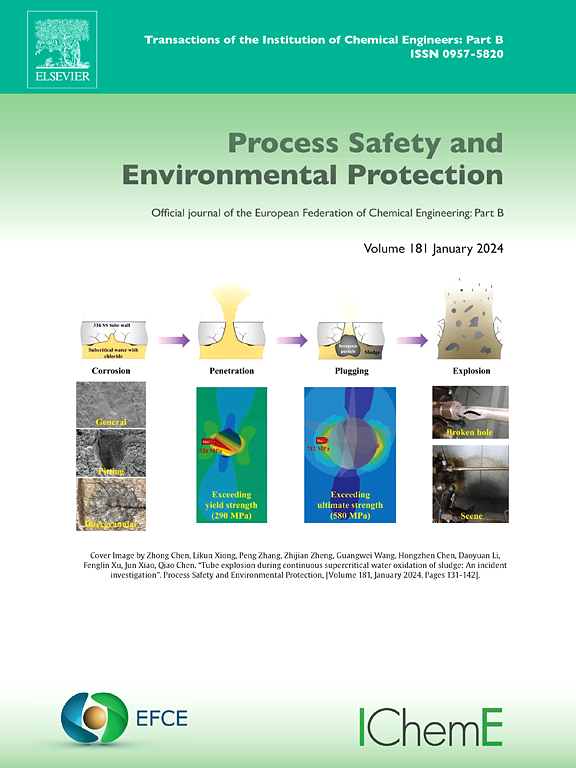由蓝藻华衍生的基于eps的水凝胶实现闭环氨去除
IF 7.8
2区 环境科学与生态学
Q1 ENGINEERING, CHEMICAL
引用次数: 0
摘要
湖泊频繁的富营养化加剧了氨氮污染,而蓝藻生物量的利用效率低下阻碍了有效的修复。在这项研究中,通过离子交联/聚合诱导策略,以蓝藻浆液中的胞外多糖(EPS)为原料,制备了一种新型的蓝藻胞外多糖水凝胶(EPSH)。这种方法稳定了EPS结构,并使自我维持的生物质来源的修复系统成为可能。EPSH对富营养化水体中NH4+-N的去除率高达96.19 %,显著优于NO3—N(75.05 %)和尿素-N(62.23 %)。吸附符合拟二级动力学模型(R2 = 0.981)和Freundlich等温线(R2 = 0.992),表明存在多层非均相化学吸附。FT-IR和XPS分析表明,水凝胶表面富含羧基(- coo -)和羟基(- oh)基团,这有助于静电相互作用和与NH₄+- n的氢键。分子机理研究表明,表面富集的- coo -基团通过强静电吸引和氢键作用协同捕获NH4+,吸附能(Eads)为−120.64 kcal/mol。A型氢键(2.928 Å)的结合稳定性高于B型氢键(3.453 Å)。这项工作为缓解富营养化湖泊中的nh4 +热点提供了一个强大的、生态友好的闭环策略。本文章由计算机程序翻译,如有差异,请以英文原文为准。
Closed-loop ammonium removal enabled by EPS-based hydrogel derived from cyanobacterial blooms
Frequent eutrophication in lakes has intensified ammonium (NH4+-N) pollution, while the inefficient utilization of cyanobacterial biomass hinders effective remediation. In this study, a novel cyanobacterial extracellular polysaccharide hydrogel (EPSH) was developed via an ion crosslinking/polymerization-induced strategy using extracellular polysaccharides (EPS) from cyanobacterial slurry. This approach stabilized the EPS structure and enabled a self-sustaining, biomass-derived remediation system. EPSH exhibited a high NH4+-N removal efficiency of 96.19 % in eutrophic water, significantly outperforming NO3--N (75.05 %) and Urea-N (62.23 %). The adsorption followed a pseudo-second-order kinetic model (R2 = 0.981) and Freundlich isotherm (R2 = 0.992), indicating multilayer heterogeneous chemisorption. FT-IR and XPS analyses revealed that the hydrogel surface was rich in carboxyl (-COO-) and hydroxyl (-OH) groups, which contributed to electrostatic interactions and hydrogen bonding with NH₄+-N. Molecular mechanism studies showed that surface-enriched -COO- groups cooperatively captured NH4+ via strong electrostatic attraction and hydrogen bonding, with an adsorption energy (Eads) of −120.64 kcal/mol. Type A hydrogen bonds (2.928 Å) exhibited higher binding stability than Type B (3.453 Å). This work offers a robust, eco-friendly, and closed-loop strategy for mitigating NH₄+ hotspots in eutrophic lakes.
求助全文
通过发布文献求助,成功后即可免费获取论文全文。
去求助
来源期刊

Process Safety and Environmental Protection
环境科学-工程:化工
CiteScore
11.40
自引率
15.40%
发文量
929
审稿时长
8.0 months
期刊介绍:
The Process Safety and Environmental Protection (PSEP) journal is a leading international publication that focuses on the publication of high-quality, original research papers in the field of engineering, specifically those related to the safety of industrial processes and environmental protection. The journal encourages submissions that present new developments in safety and environmental aspects, particularly those that show how research findings can be applied in process engineering design and practice.
PSEP is particularly interested in research that brings fresh perspectives to established engineering principles, identifies unsolved problems, or suggests directions for future research. The journal also values contributions that push the boundaries of traditional engineering and welcomes multidisciplinary papers.
PSEP's articles are abstracted and indexed by a range of databases and services, which helps to ensure that the journal's research is accessible and recognized in the academic and professional communities. These databases include ANTE, Chemical Abstracts, Chemical Hazards in Industry, Current Contents, Elsevier Engineering Information database, Pascal Francis, Web of Science, Scopus, Engineering Information Database EnCompass LIT (Elsevier), and INSPEC. This wide coverage facilitates the dissemination of the journal's content to a global audience interested in process safety and environmental engineering.
 求助内容:
求助内容: 应助结果提醒方式:
应助结果提醒方式:


